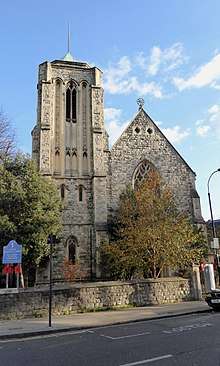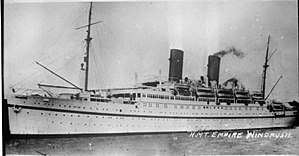St Stephen's Church, Shepherd's Bush
| St Stephen and St Thomas | |
|---|---|
 Church of St Stephen and St Thomas, Shepherd's Bush | |
| Location | Uxbridge Road, London |
| Country | United Kingdom |
| Denomination | Church of England |
| History | |
| Dedication |
St Stephen St Thomas |
| Architecture | |
| Architect(s) | Anthony Salvin |
| Style | Victorian Gothic |
| Years built | 1849-50 |
| Administration | |
| Diocese | London |
| Clergy | |
| Vicar(s) |
Reverend Dr Bob Mayo Reverend Anne Cowley |
The Church of St Stephen and St Thomas is a Church of England parish church in Shepherd's Bush, London. It was built circa 1849–50, designed by architect Anthony Salvin in the Gothic Revival style with a tower. The church is located on the south side of Uxbridge Road on the corner of Coverdale Road, to the west of Shepherd's Bush tube station. In the 1950s St Stephen's welcomed many members of the so-called "Windrush Generation" from the West Indies, and in 1962 the Barbadian-born Rev Wilfred Wood became curate to St Stephen's, later becoming the Church of England’s first black bishop. In 1966 the vicar John Asbridge, frustrated by the chronic shortage of local housing, set up the Shepherds Bush Housing Association to help solve the problems of homelessness and poverty in the area. Today St Stephen's ministers to a diverse congregation, and serves a hot meal to up to 100 homeless people every Monday. The church is on Historic England's "At Risk" Register and an appeal has been launched to raise funds to repair the decaying Victorian roof.
History

19th Century Origins
The Church of St Stephen was built circa 1849–50, designed by architect Anthony Salvin, and built in the Gothic Revival style with a tower.[1]
Much of the cost of building the church was borne by Bishop Blomfield. The church was consecrated in 1850 and the whole of the parish north of the Goldhawk Road was allocated to it. However, by 1870 the expanding population of Shepherd's Bush meant that the church was already overcrowded.[2]
On completion, the periodical The Ecclesiologist, which was strongly in favour of the Gothic Revival movement, commented that the new church:
- "has a peculiar value, as indicating how far our diocesan is willing to take the peculiar responsibility of those various features of the arrangements and decoration, which from desuetude had become to a great extent novelties in England when we first advocated their revival".[1]
St Stephen's was built of Kentish Ragstone with Bath stone dressings. It had a "very well developed chancel". The stained glass windows were manufactured by William Wailes and were donated by members of the clergy and other well-wishers.[1]
St Stephen's was built as a so-called "Commissioners' church"; an Anglican church in the United Kingdom built with money voted by Parliament as a result of the Church Building Act 1818, and subsequent related Acts. Such churches have been given a number of titles, including "Commissioners' Churches", "Waterloo Churches" and "Million Act Churches". In some cases the Commissioners provided the full cost of the new church; in other cases they provided a grant and the balance was raised locally.
The pipe organ was by made by Henry Willis & Sons in 1888.
In 1850 William Cooke became priest in charge of St Stephen's.[3]
Second World War and aftermath
The church was hit by enemy bombing in 1940 or 1941 and much damage was caused. The original spire was damaged, apparently beyond repair. In 1949 scaffolding was erected to effect repairs, but the spire could not be saved, and was taken down and replaced by the present structure, a low octagonal copper flèche.[4] In the same raid the original stained glass windows on the north side of the church were destroyed, as well as the great east and west windows.[5]
Post War Era and the Windrush Generation
In 1950 centenary celebrations were held, including a "great pageant" and a "centenary dinner", attended by William Wand, the Bishop of London.[4]
In the 1950s many immigrants from the West Indies settled in Shepherds Bush, with St Stephen’s becoming known as a church that welcomed what would become known as the Windrush Generation. In 1962 the Barbadian-born Rev Wilfred Wood became curate to St Stephen's.[6] Wood was a lifelong champion of racial justice, who in 1985 became the Church of England’s first black bishop. Bishop Wood's influence is still felt today as many West Indian families remain rooted in St Stephen’s.[6]
In 1960 the parish was amalgamated with that of St Thomas, forming the new parish of St Stephen's and St Thomas.[4]
Shepherds Bush Housing Association
In 1966 the Rev John Asbridge, vicar of St Stephen's, set up the Shepherds Bush Housing Association, in order to help solve the urgent need for housing for poor parishioners. The choir vestry at St Stephen’s was used as an office, which was run by volunteers from the parish. In addition, help was given by a number of parishioners who gifted their own houses to the association for use by homeless people.[6] Their first acquisition was a dilapidated house at 220 Hammersmith Grove, which was converted into flats. Asbridge ran the Association for 20 years, retiring in 1988.[7] Today, the Shepherd's Bush Housing Association owns and manages more than 5,000 homes.[8]
St Stephen's today

Today St Stephen's continues to minister to the spiritual needs of the community. Services are held on Sundays at 10am. At 6.30 pm is evening prayer, a "quiet reflective service" held on the first Sunday of the month. On Thursday at 6.30pm there is a "Christian meditation".[9]
The Church also runs a primary school called St Stephen's School, Shepherd's Bush.[10] In 2008 Ofsted reported that it was "a good school with a number of outstanding features".[11]
St Stephen's is listed by Historic England in their "Heritage at Risk" category, due to "roofs and rainwater goods ... in poor condition resulting in water ingress".[12] St Stephen's has launched an appeal to raise £200,000 to effect repairs.[13]
Gallery
 1888 Pipe Organ by Henry Willis & Sons
1888 Pipe Organ by Henry Willis & Sons
See also
| Wikimedia Commons has media related to Saint Stephen Church (Shepherd's Bush). |
Notes
- 1 2 3 Melanie Barber, Gabriel Sewell & Stephen Taylor, p.401, From the Reformation to the Permissive Society: a Miscellany, Lambeth palace Library Retrieved January 2012
- ↑ Denny, p.58
- ↑ "Cooke, William (CK836W)". A Cambridge Alumni Database. University of Cambridge.
- 1 2 3 Porter, p3
- ↑ Byford, p2
- 1 2 3 Byford, p3
- ↑ Interview with John Asbridge Retrieved 19 July 2017
- ↑ Official Website of the SBHG Retrieved 19 July 2017
- ↑ Official St Stephen's and St Thomas website Retrieved February 2014
- ↑ Official School website Retrieved March 2012
- ↑ teachweb.co.uk Retrieved March 2012
- ↑ Historic England At Risk Register Retrieved 20 July 2017
- ↑ St Stephen's Roof Appeal Official Site Retrieved 20 July 2017
References
- Byford, Juliet, History of St Stephen's Church Shepherd's Bush, official pamphlet published by St Stephen's Church, July 2017
- Denny, Barbara, Hammersmith and Shepherd's Bush Past, Historical Publications Ltd, London 1995
- Porter, Ronald, A History of St Stephen's Church Shepherd's Bush, official pamphlet published by St Stephen's Church, c1960
External links
- Official St Stephen's and St Thomas website Retrieved September 2015
- Official St Stephen's Roof Fund Website Retrieved 20 July 2017
